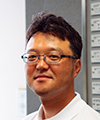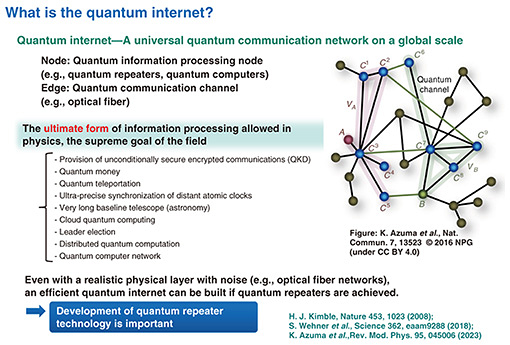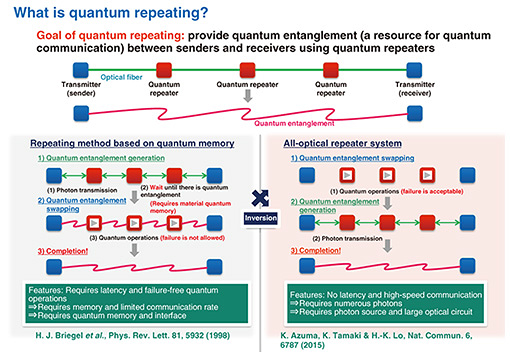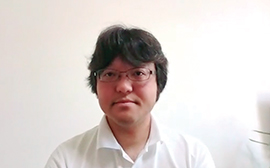 |
|
|
|
|
|
Rising Researchers Vol. 22, No. 10, pp. 13–18, Oct. 2024. https://doi.org/10.53829/ntr202410ri1  Developing a Theory for a Quantum Internet for Global Quantum CommunicationAbstractQuantum mechanics emerged a century ago. It abandoned the deterministic worldview that underlies classical mechanics for a more general theoretical system. It is now believed that everything should be described by quantum mechanics. Furthermore, in our efforts to rethink the theoretical system for information processing based on the classical worldview within the framework of quantum mechanics, it has become clear that even information processing tasks that were previously considered intractable can now be performed within the framework of quantum mechanics. For this issue, we interviewed NTT Distinguished Researcher Koji Azuma, a leader in the field of quantum network research at NTT, about his current research and his mindset as a researcher. Keywords: quantum network, quantum internet, quantum repeater A new method that overturns conventional wisdom will bring the future of the “all-optical quantum internet” to life—First of all, what does it mean to develop a quantum network theory? My research is about developing a quantum network theory. It is aimed at identifying a future vision of the “quantum internet,” the ultimate type of a communication network allowed in the framework of quantum mechanics. One of the roles of theory in physics is to predict the future with a high degree of certainty. Classical mechanics, as typified by Newtonian mechanics, gives a 100% correct prediction of the “in principle, this will always happen” sort. But in the microscopic world of atoms and elementary particles, there are phenomena that cannot be explained by classical mechanics. That is where quantum mechanics comes in. This is a broader theoretical system than classical mechanics in that, like weather forecasting, it only goes so far as to say the probability that a phenomenon will occur. It provides highly accurate explanations for phenomena at various levels, from the microscopic world to the universe. Quantum mechanics is now considered to be the theory of everything, and even when a theory has worked well in classical mechanics, for example the theory of gravity, it remains one of the fundamental efforts in modern physics to rethink it, or “quantize” it, in the broader framework of quantum mechanics. At the same time, physics also underlies information processing technologies such as telecommunications and computers, which were invented in the last century and have influenced modern society. This idea was popularized in the 1990s by Rolf Landauer (then an IBM Fellow) with his slogan “Information is physical” (Fig. 1). For example, when we communicate information in our brain in an online meeting, the information in our brain is converted into sound, the sound is picked up by a microphone and converted into an electrical signal, and so on... In general, information processing is done through physical systems and physical processes, which means that information processing follows physical laws. However, current information processing technologies such as computers and telecommunications are only built on a classical mechanistic worldview.
Quantum information science was born out of the attempt to “quantize” this information processing, and within this field, I am working on developing the theory for a “quantum internet.” If we consider the current internet as the largest information processing network on Earth, the quantum internet, a quantum version of it, should be the ultimate information processing network (Fig. 2). The term “quantum internet” was originally introduced by H. Jeff Kimble, a professor at the California Institute of Technology, as the title of a 2008 review article in Nature. At that time, however, it was only an abstract concept of a “quantum information processing network” in which quantum information processing nodes such as quantum computers and quantum memories were connected by quantum communication channels such as optical fibers and free space. My research aims to give shape to the quantum internet, which at the time was only an abstract concept.
—What kind of research are you working on to realize the quantum internet? In order to instantiate and realize the quantum internet (which was an abstract concept), a quantum communication channel is first needed to transmit the quantum systems that carry quantum information. In conventional communications, optical fiber and free space are used as communication channels, and signals are amplified using repeaters and amplifiers to counter the noise and loss they have. However, since quantum information cannot be duplicated or amplified in principle (no-cloning theorem), signal amplification cannot be used in the transmission of quantum information. The “quantum repeater” was proposed in 1998 as a method to solve this problem. This method works by placing multiple special devices called “quantum repeaters” between the sender and receiver and connecting them with each other via quantum communication channels, enabling faithful and efficient quantum communication regardless of the distance between the sender and receiver, even if the quantum communication channels have noise or loss. Around 2010, when I started my research, it was a well-established theory that quantum repeaters are equipped with “quantum memory” to store quantum information, and I don’t think anyone had any doubts. However, a quantum repeater using conventional quantum memory requires time-consuming transmission of quantum information, and also requires quantum memory to have a quantum interface with light, which is the medium for delivering quantum information. Not only that, but there was a risk that the transmission itself would fail if the quantum computation by the repeater failed during the process, resulting in extremely high demands on the device. What led to the creation of the research that turned the situation around was a conversation with Professor Hoi-Kwong Lo at the University of Toronto, where I was accompanied by my colleague and mentor Kiyoshi Tamaki, who was then a member of the same laboratory as me. When I presented my theory of a quantum repeater based on quantum memory, I was asked a simple question: “Is quantum memory necessary for a quantum repeater to begin with?” This single remark made me rethink the conventional wisdom, and what emerged was a new quantum repeater method, “all-optical quantum repeater,” which we pioneered and announced to the world in 2015. This showed that a quantum repeater was possible simply by combining optical devices, and overturned the conventional wisdom. This method was not immediately accepted by the public at the time, when quantum memory development was being vigorously pursued for a quantum repeater. However, the situation changed drastically after a talk at the international conference QCrypt 2015, and it is now recognized as one of the two major approaches to realize a quantum repeater (quantum memory-based repeater and all-optical repeater) (Fig. 3). This all-optical quantum repeater is a milestone in the development of an “all-optical quantum computer” that realizes quantum computation using only optical devices. Furthermore, it presents the possibility of an “all-optical quantum internet” realized by connecting all-optical quantum computers with all-optical quantum repeaters. I was personally convinced from the outset that it would be significant.
—What other research are you involved in? In order to implement the all-optical quantum repeater announced in 2015 as per theory, I felt that the research would be very lengthy, requiring a special mechanism called “quantum error correcting code,” and that the field might “run out of breath.” In that context, I wanted a research subject that would be a milestone in the realization of an all-optical quantum repeater. I set out to find a method that would bridge the technical and conceptual gap between an all-optical quantum repeater, which has no communication distance limit, and the point-to-point quantum key delivery method, which, although limited in communication distance, was already in the practical application stage. The distance limit for point-to-point quantum key delivery, which directly links the sender and receiver via fiber without using any relay points, was estimated to be about 400 km in fiber distance. To overcome this, I proposed with William J. Munro, the group leader at the time, and others the idea of placing only one measurement device in the middle of the sender and receiver. This has revealed the possibility of doubling the communication distance without requiring quantum memory or a quantum error correcting code, while maintaining the communication rate of the point-to-point quantum key delivery method, and thus enabling communication up to 800 km. Among them, the twin-field quantum key delivery method that I proposed in 2019 with Marcos Curty and Professor Lo from the University of Vigo is now called the CAL19 method and has been adopted by various teams around the world for their quantum key delivery implementation. After discussions with Akihiro Mizutani, who was resident with Professor Lo’s group, we initiated research to extend the theoretical limits of the point-to-point method, which had just been derived at that time. We were the first to present the limits of “quantum communication capacity” and “secret communication capacity,” which are the capacity for communication that any quantum network has. This has helped to lay out a theoretical framework for properly handling the previously ambiguous “quantum internet” and has provided a road map for the design of efficient quantum internet protocols. In fact, inspired by this, Professor Go Kato (who belonged to NTT Communication Science Laboratories at the time) and I proposed a communication method in which quantum repeaters are run in parallel between two parties on a quantum network. We have even found that the efficiency of this method is consistent with the theoretical limit when the communication channel consists of optical fibers. These results show that a quantum repeater can play a fundamental role in the development of a high-performance quantum internet at or near the theoretical limit. I believe that this series of studies on quantum networks contributed to the linking and substantiation of the concept of a quantum repeater (which had existed since 1998) and the abstract concept of quantum internet (proposed by H. Jeff Kimble). In fact, we were able to compile these findings into a review paper titled “Quantum repeaters: From quantum networks to the quantum internet” with leading researchers from around the world, which was published last year in Reviews of Modern Physics.
A beautiful theory with “simplicity” will be passed down to future generations—What are your future research prospects? The quantum internet has many potential applications. One of them is to enable quantum key delivery between arbitrary users on a network. Quantum key delivery, a type of quantum cryptography, can provide information-theoretically secure cryptographic communications even if an eavesdropper commits any eavesdropping act allowed by quantum mechanics (e.g., eavesdropping with a quantum computer). Therefore, it is likely to be applied in situations that require a high level of security, such as referendums, summit meetings, financial transactions, and the exchange of genetic and biometric information. Other applications include quantum teleportation to faithfully transfer information about quantum systems to distant points at the speed of light, precise and covert synchronization of atomic clocks to enable stable, accurate, and secure sharing of world clocks, and very long baseline telescope arrays. In addition, research on quantum computers is spreading beyond academia to companies, and there is accelerating development toward commercialization. Unlike quantum computers, which are primarily for personal use, quantum communications, and hence the quantum internet, is an infrastructure whose value increases with the number of users, and therefore must be built and expanded at the national level based on a scalable grand design. Therefore, I believe that research to articulate the design of scalable middleware and software, as well as standardization, will be important efforts. —What is your impression of NTT laboratories? NTT Basic Research Laboratories has been conducting research on quantum information since the dawn of the field in the 1990s and is a center of quantum information research in Japan. In fact looking back, there were many people around me from NTT Basic Research Laboratories. Professor Nobuyuki Imoto (currently a specially-appointed professor at the University of Tokyo), who was a professor in the Quantum Information Laboratory at Osaka University, which I belonged to, and Professor Masato Koashi (currently a professor at the University of Tokyo), who was an associate professor at Osaka University, belonged to NTT Basic Research Laboratories before they transferred to the university. Professor Masahiro Kitagawa (currently a specially-appointed professor at Osaka University) had been in close contact with the Imoto Lab at Osaka University and was also conducting pioneering research in the field of quantum information. And what I found when I actually joined NTT is that even if a field is currently in its budding stage (like quantum information research 30 years ago), NTT has an environment that will support your research over the long run if it is intrinsically important. This is a rare laboratory in the world, and I feel blessed to have it. —Finally, do you have a message for researchers, students, and business partners? What I value in my research is to pursue theories that, even if they are not understood at the time of publication, will be recognized over time and become “the norm” in the future. Personally, I believe that is the kind of research that will endure, and I think it is very important to explore the possibilities of this kind of research, especially with basic research. What I always keep in mind is to what degree the impact of our research will remain over a longer time frame. While it is important for an ordinary product, for example, to affect many people at the same time, this is not necessarily the case for research. Some of Einstein’s papers have become more widely cited since his death, and on a related note I am always mindful of the question of how long research can captivate many people. I also note that such an enduring theory always encompasses simplicity. If the theory is correct and valuable, and if it is published and recognized by the public, it will then spread on its own without any arbitrary intervention. I still look for puzzles and their pieces, always asking myself questions such as, “What conception of nature and what technologies will become standard in the future?” and “What is a fundamental problem that I would be elated to solve?” While it can be a struggle, it can also be an incomparable joy when you find a problem and solve it. I hope that this article will make some of you think, even if only a little, that you should “value your own sensibilities” in your research and work, and that you should “devote yourself to what you, not others, believe is valuable.” ■Interviewee profileKoji Azuma received a Ph.D. from the Department of Materials Science, Graduate School of Engineering Science, Osaka University in 2010. In the same year, he joined Nippon Telegraph and Telephone Corporation. Since joining NTT Basic Research Laboratories, he has been engaged in theoretical research on quantum information theory, especially quantum repeaters and quantum internet. He was a visiting scholar at the University of Toronto from 2012 to 2018; a visiting scholar at the University of Cambridge in 2019; and a JST PRESTO (concurrent) researcher from 2018 to 2022. He has been an invited associate professor at the Graduate School of Engineering Science, Osaka University since 2019 and an editor of Optica Quantum since 2023. |




